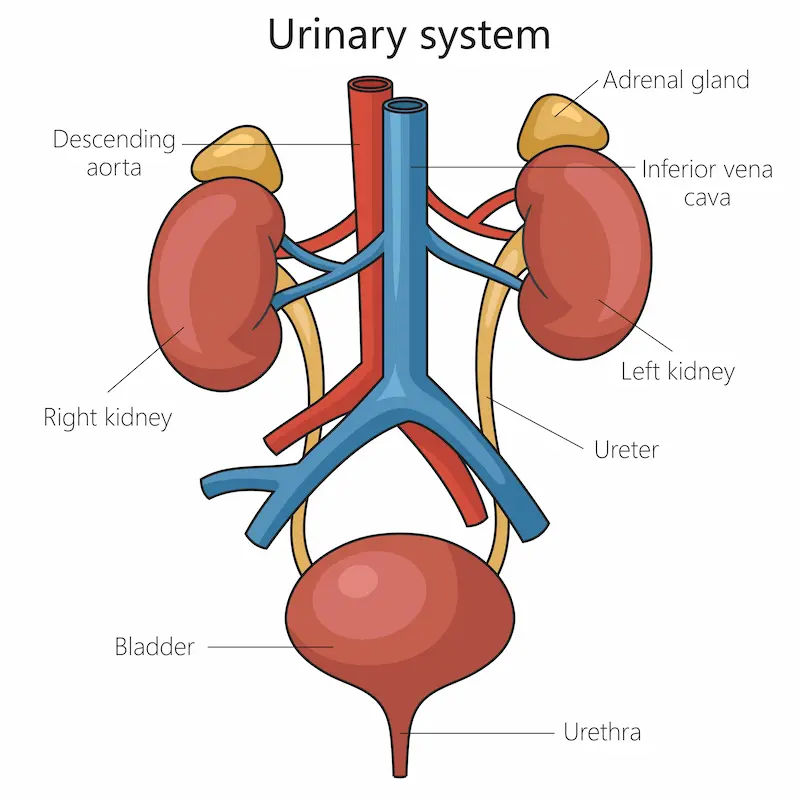Guide to Know More About Robotic Urology Surgery
Discover the benefits, procedures, and recovery associated with robotic-assisted urology surgery. Get the definitive guide to understanding this advanced surgical technique for conditions like prostate and kidney cancer.

Written by Dr. J T Hema Pratima
Reviewed by Dr. Rohinipriyanka Pondugula MBBS
Last updated on 6th Oct, 2025

Introduction
Facing a urological condition that requires surgery can be daunting. The thought of large incisions, significant pain, and a long recovery period is enough to cause anxiety. However, the field of urology has been revolutionized by technology, leading to the advent of robotic urology surgery. This isn't about robots operating autonomously; it's about empowering surgeons with unparalleled precision and control for minimally invasive procedures. This guide will demystify this advanced surgical approach, exploring its benefits, the conditions it treats, and what you can realistically expect from consultation to recovery.
What is Robotic Urology Surgery? Beyond Science Fiction
When you hear "robotic surgery," you might picture a futuristic scene from a movie. In reality, robotic urology surgery is a form of minimally invasive laparoscopic surgery where a surgeon uses a sophisticated computer console to control miniature instruments attached to robotic arms. The most common system used worldwide is the Da Vinci Surgical System. This technology translates the surgeon’s hand movements into smaller, precise movements of the instruments inside your body, allowing operations to be performed through a few small incisions, often no larger than a centimeter.
The Surgeon is Always in Control: How the Technology Works
The system consists of three key components:
1. The Surgeon Console: This is where your surgeon sits, viewing a magnified, high-definition 3D image of the surgical site. They control the instruments with their fingertips, and the system filters out any tremors, ensuring steady movement.
2. The Patient-Side Cart: Positioned next to you, this unit holds the robotic arms that hold the instruments and the camera.
3. The Vision System: This provides the brilliant 3D view that gives the surgeon a depth of field similar to open surgery but through a very small incision.
It's crucial to understand that the robot does not move on its own. Every single movement is directly dictated by your surgeon in real-time.
Common Urological Conditions Treated with Robotics
Robotic systems are exceptionally well-suited for procedures in the confined space of the pelvis and abdomen. They are commonly used for:
Prostate Cancer: Radical prostatectomy (removal of the prostate gland).
Kidney Cancer: Partial or radical nephrectomy (removal of part or all of the kidney).
Bladder Cancer: Radical cystectomy (removal of the bladder).
Kidney Blockages: Pyeloplasty (repair of a blockage at the kidney junction).
Other conditions: Such as repairing ureteral strictures or treating adrenal gland tumors.
Robotic Surgery vs. Traditional Open Surgery: A Clear Comparison
The fundamental difference lies in the approach. Open surgery requires one large incision to access the organ, while robotic assisted laparoscopic surgery uses several small keyhole incisions.
Health Topic Carousel:
Doctor Speciality: General Physician
Text: Consult Top Specialists
Key Advantages of Choosing a Robotic Procedure
The benefits of this minimally invasive approach are significant:
Less Pain and Discomfort: Smaller incisions mean less damage to muscles and tissue, leading to considerably less post-operative pain.
Reduced Blood Loss: The precision of the instruments and the enhanced visualization help surgeons avoid nicking blood vessels, minimizing blood loss and the need for transfusions.
Shorter Hospital Stay: Many patients undergoing a robotic prostatectomy can go home within 24 hours, compared to several days for open surgery.
Faster Recovery Time: Patients typically return to normal activities and work much sooner.
Superior Precision and Visualization: The 3D, high-magnification view allows surgeons to see intricate structures like nerves and blood vessels with exceptional clarity, which is crucial for procedures like nerve-sparing prostatectomy that can help preserve urinary and sexual function.
Minimal Scarring: The small incisions result in barely noticeable scars versus one large scar.
Understanding the Potential Risks and Limitations
While highly safe, robotic surgery carries general surgical risks like infection or bleeding. Specific to the technology, there is a rare risk of instrument malfunction or the need to convert to an open procedure if complications arise. Furthermore, the cost of robotic urology surgery can be higher due to the advanced technology involved. The success of the procedure is also highly dependent on the surgeon's skill and experience with the robotic platform.
A Closer Look at Common Robotic Urology Procedures
Robotic Prostatectomy for Prostate Cancer
This is one of the most common robotic urologic oncology procedures. The surgeon removes the entire prostate gland with pinpoint accuracy. Studies have shown that robotic-assisted surgery can lead to better outcomes in preserving continence (bladder control) and erectile function compared to open surgery, thanks to the enhanced ability to spare the delicate nerves surrounding the prostate.
Robotic Partial Nephrectomy for Kidney Tumors
The goal here is to remove the cancerous tumor while preserving as much healthy kidney tissue as possible. The robot’s precision is vital for clamping the kidney's blood supply, removing the tumor, and reconstructing the kidney with fine sutures—all within a limited time frame to protect the organ's function. This minimally invasive kidney surgery is the gold standard for treating many small kidney tumors.
Other Procedures: Pyeloplasty, Cystectomy, and More
Pyeloplasty: Used to correct a blockage where the kidney meets the ureter, this procedure has a very high success rate when performed robotically.
Radical Cystectomy: For bladder cancer, this complex procedure involves removing the bladder and creating a new way for urine to exit the body. The robotic approach significantly reduces the morbidity of this major operation.
The Patient Journey: From Consultation to Full Recovery
What to Expect Before Your Robotic Surgery?
Your journey begins with a detailed consultation with your urologist. They will determine if you are a good candidate based on your specific condition and overall health. This may involve pre-operative tests. If you have underlying health conditions like diabetes or heart issues, it's important to discuss these with your doctor on Apollo24|7 to ensure you are optimized for surgery.
A Typical Day of the Procedure
You will be placed under general anesthesia. The surgeon will make a few small incisions for the robotic arms and camera. The procedure can take several hours, depending on its complexity. Throughout, the surgical team will be monitoring you closely.
The Road to Recovery: Post-Op Care and Timeline
In the Hospital: You might have a catheter and drains, which are usually removed before discharge. Pain is typically managed effectively with oral medication.
At Home: The recovery time for robotic prostate surgery is notably faster. Most patients can resume light activities within a week or two. Strenuous activities and heavy lifting should be avoided for about 4-6 weeks. Your surgeon will provide specific instructions on wound care, diet, and follow-up appointments. Adherence to these guidelines is key to a smooth recovery.
Is Robotic Urology Surgery Right for You?
The decision is multifaceted. It depends on your specific diagnosis, the stage of your disease, your overall health, and the expertise of your surgical team. While robotic surgery offers numerous advantages, it may not be suitable for every patient or every condition. A thorough discussion with an experienced urologist is essential. You can consult with a specialist urologist on Apollo24|7 to get a personalized opinion on whether this advanced approach is the best path for your treatment.
Health Topic Carousel:
Doctor Speciality: General Physician
Text: Consult Top Specialists
Conclusion: Embracing Precision in Urological Care
Robotic urology surgery represents a significant leap forward in patient care. By minimizing the physical trauma of surgery, it transforms what was once a major life disruption into a manageable event with a swift return to normal life. The combination of a surgeon's expertise with the precision of robotic technology offers hope and improved outcomes for patients facing urological conditions. If you or a loved one are considering surgery, being informed about this option empowers you to have a productive conversation with your healthcare provider about the best possible path to healing.
Frequently Asked Questions (FAQs) About Robotic Urology Surgery
1. How long does a typical robotic urology surgery take?
A. Operation times vary by procedure. A robotic prostatectomy may take 2-4 hours, while a more complex cystectomy can take 4-6 hours. This is often comparable to or slightly longer than open surgery, but the benefits are seen in the recovery phase.
2. What is the success rate of robotic prostate surgery?
A. Success rates are very high. For cancer control, robotic prostatectomy has shown success rates equivalent to or exceeding open surgery. In terms of functional outcomes (preserving continence and potency), many studies indicate potentially better results due to the enhanced precision of the nerve-sparing technique.
3. Are there any activity restrictions after robotic kidney surgery?
A. Yes. While recovery is faster, you must avoid heavy lifting (anything over 10-15 pounds) and strenuous exercise for about 4-6 weeks to allow your internal incisions to heal properly and prevent hernias.
4. Is robotic surgery covered by insurance?
A. In most cases, yes. Robotic surgery for medically necessary procedures like cancer treatment is typically covered by insurance plans in the same way as open surgery. However, it's always best to check with your specific insurance provider and hospital for details on coverage.
5. How do I find a qualified robotic urology surgeon?
A. Look for a urologist who is fellowship-trained in robotic or minimally invasive surgery and has performed a high volume of the specific procedure you need. Don't hesitate to ask a surgeon about their experience and outcomes during a consultation.
Consult Top Specialists for Personalised Tips

Dr. Ramya Hari
General Practitioner
18 Years • Medical Head & Family Physician, DG Shipping Approved Doctor, Panel Physician - UK Visa Medicals
Chennai
Apollo Medical Centre Kotturpuram, Chennai

Dr. Om Prakash Sharma
General Physician/ Internal Medicine Specialist
46 Years • MD, FRCP (Edinburg), FICN, FICP, FIAMS, FCGP, FGSI, FACM, FIMSA, FGAPIO
Delhi
Apollo Hospitals Indraprastha, Delhi

Dr. Subramony H
General Physician/ Internal Medicine Specialist
25 Years • MBBS, MD
Chennai
Apollo Hospitals Greams Road, Chennai
(50+ Patients)

Dr. Rama Narasimhan
General Physician/ Internal Medicine Specialist
20 Years • MBBS, MD
Chennai
Apollo Hospitals Greams Road, Chennai

Dr. Promise Jain
General Physician/ Internal Medicine Specialist
20 Years • MBBS, DNB Medicine, TDD, MNAMS, PGCDM, CCEBDM, CCMTD,PGDE Senior Consultant- Internal Medicine Head- Department of critical care Apollo Sage Hospital, Bhopal, MP Intensivist, Diabetes, Thyroid , Physician
Bhopal
Apollo Sage Hospitals, Bhopal
Consult Top Specialists

Dr. Ramya Hari
General Practitioner
18 Years • Medical Head & Family Physician, DG Shipping Approved Doctor, Panel Physician - UK Visa Medicals
Chennai
Apollo Medical Centre Kotturpuram, Chennai

Dr. Om Prakash Sharma
General Physician/ Internal Medicine Specialist
46 Years • MD, FRCP (Edinburg), FICN, FICP, FIAMS, FCGP, FGSI, FACM, FIMSA, FGAPIO
Delhi
Apollo Hospitals Indraprastha, Delhi

Dr. Subramony H
General Physician/ Internal Medicine Specialist
25 Years • MBBS, MD
Chennai
Apollo Hospitals Greams Road, Chennai
(50+ Patients)

Dr. Rama Narasimhan
General Physician/ Internal Medicine Specialist
20 Years • MBBS, MD
Chennai
Apollo Hospitals Greams Road, Chennai

Dr. Promise Jain
General Physician/ Internal Medicine Specialist
20 Years • MBBS, DNB Medicine, TDD, MNAMS, PGCDM, CCEBDM, CCMTD,PGDE Senior Consultant- Internal Medicine Head- Department of critical care Apollo Sage Hospital, Bhopal, MP Intensivist, Diabetes, Thyroid , Physician
Bhopal
Apollo Sage Hospitals, Bhopal



